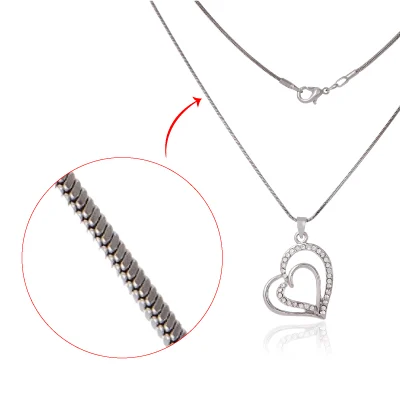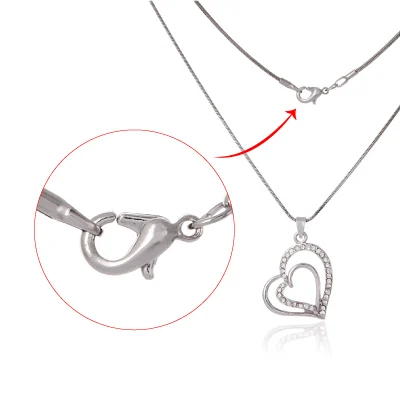
Hold a Sheet of paper in your hand. Seems simple, right? Well, that one sheet of paper is a result of 14 different processes. Similarly, Necklaces! Seems simple, seems complete, But do you know there are 6 different parts to it?
So, when one thinks of what are the parts of a necklace called? Surely the most vital part would have to be the chain.
If “Why should I know about these parts?” is what you are wondering, here’s why:
Knowing the parts of the necklaces goes a long way. If not knowing were to be explained, it is like a worksman, who doesn’t knows his tools. However, by knowing them, it’s easier to get work done.
In the case of necklaces, if you are aware of the below mentioned parts of necklaces, you can be great at buying necklaces. However, BOLD is among the only platforms to provide descriptions for jewelry products so you can learn from it.
Furthermore, this knowledge also helps you pair the necklaces better and customize them. You can prevent allergies and skin reaction to certain metals and materials.
Now, without further ado, here are the different parts of necklace!

The chain is literally the backbone of a necklace, holding everything in place. It does come in various materials, though gold, silver, and stainless steel are some of the most widely used today.
Some of the popular styles will include:
Even with non-metal material, such as leather cords, some unique style has its own place, casual in nature. Choose a chain length and width that feels comfortable around your neck based on your body type.

What it is: The pendant is the most prominent part of a necklace; it hangs from the chain, quite often serving as the centrepiece.
Variety: From minimalist geometric shapes to elaborately designed pendant pieces with stones, pendants come in great variety. Popularity has showered lockets that open for holding small keepsakes or pictures.
Materials: Pendants can be made from various metals, such as gold, silver, and rose gold, and are quite often studded with diamonds, sapphires, or emeralds to give them that extra glamour.
Why It Matters: The pendant is significant in making your necklace unique. It brings individuality to your look for daily wear or special occasions and adds sentimental value with personal touches.

It is the clasp, better known as the fastener—the very important part that keeps the necklace in place. It has two parts: one opens, while one stays fixed, designed to attach to a jump ring or another point of connection.
Lobster Clasp: This is the popular and easy-to-use clasp resembling a lobster claw. It has a small toggle at the end with which to open the clasp.
Magnetic Clasp: Good for people with less dexterity, as these use magnets to fasten easily. However, this may not work for heavy pendants.
Spring Ring Clasp: Small and discreet, with a lever that opens the clasp. Secure, though it can be difficult for some people to use.
Choose the Right Clasp: The best choice of clasp will be to consider things such as ease of use, size, and durability. Larger clasps are easier to handle but may be less comfortable for long wear.
What they are: Jump rings are small circular rings that play a substantial role in the joining of different parts of a chain necklace. They link the chain to pendants, clasps, or other findings, keeping the whole necklace intact.
Importance: These are important components of a chain necklace, allowing adding versatility. They serve to attach charms or pendants in place, providing security and allowing personalization. Jump rings can be made from different metals, such as gold, silver, or even stainless steel, and they come in different sizes according to the design of a necklace.
Jump Ring Choosing: Choose the jump rings that are strong, well made, and matching in metal with your necklace to look great.
A necklace extender is one thing that you need to make any necklace part more versatile. That is a little extra chain that attaches to your necklace for easy adjustments in length. This handy accessory works great when you just need a little extra room or for when you might want to manipulate the fit due to different necklines. Be it that your necklace is to be a little bit longer or shorter, make sure that your jewelry can be tailored with a necklace extender to fit all style needs of yours.
The easiest and most practical way of giving your favorite necklaces an elevation in functionality, is the Extenders.
What They Are: Beads and charms are decorative elements added to a necklace. They can either be strung along the chain or attached by jump rings, adding so much personality to your design.
Types: The material used in making beads can be glass, wood, or even gemstones. On the other hand, charms are usually small symbolic or figurative pendants.
Importance: These components of a necklace let you personalize so that you can express yourself—your style, personality—right out of a jewelry piece. Beads and charms make the necklace truly one-of-a-kind.
Knowing what the parts of a necklace are called will help you us appreciate how each one contributes to a design. From the parts of a chain necklace, which include the chain itself, the clasp, and jump rings, to other decorative features like beads and charms, everything has a purpose.
All the components come together to create a custom-made piece of jewelry. The chain serves as the backbone, while the clasp holds it in place. Jump rings are used to attach pendants, beads, and charms to the necklace for the purpose of customization.
Surely, the more you know, the better or just make things easier by getting your jewelry from BOLD! From the best prices to the best designs, BOLD’s jewelry collection is your Eureka moment!